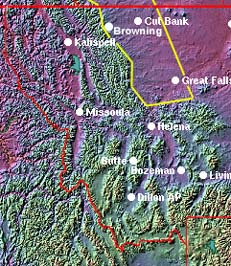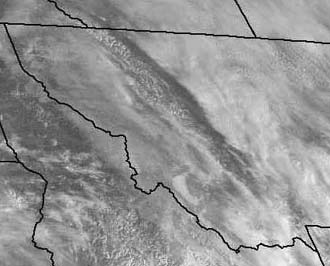

 
The lay of the land . . .
A More technical version . . . A Chinook arch implies the presence of "mountain waves". Strong lower and middle level winds are forced upwards as they encounter mountains. The winds then travel downwards once they get over the crest of the mountains. These winds can then oscillate up and down as they travel away from the mountains (like a boat on a lake as waves pass underneath) for several hundred miles! In order for this oscillation to take place, the atmosphere must be "stable". A stable atmosphere implies that if a parcel of air was moved upwards, it would sink downwards to its original level. In other words, once displaced...this parcel would be cooler than the surrounding air...so it would sink. The opposite is also true. If a parcel was displaced downwards, it will return upwards to its original level. This would occur because the parcel of air would be warmer than its surroundings, thus it would rise. These parcels will not just stop at their original level. Since they are gaining momentum while rising or sinking, they will tend to "overshoot" the original level. For instance, when your traveling down the road and go over a big bump, your car will oscillate up and down as your shocks and struts absorb the force. Eventually, your car is returned to equilibrium...a smooth ride. The same can be said of a pendulum. Move it to one side and let it go and gravity takes over. It will not initially stop at 6 o'clock because the momentum the pendulum builds up will take it past that point. Eventually of course, it will come to a rest after several swings back and forth. So as the air parcels are forced up over the mountain, they want to return to their original level due to the stable atmosphere. They travel down the lee side of the mountain...but momentum carries them too far. They therefore take an upward turn even farther from the mountains. Again, this mountain wave process can go on for several hundred miles as the parcels try and return to their original level. These air parcels don't just oscillate up an down since wind is also driving them horizontally. The combination of the oscillation and forward momentum produce the mountain wave effect. That is why the air rises again after initially traveling down the lee side of the mountains. To form the Chinook arch cloud - all that is now needed is sufficient moisture in the atmosphere. The presence of upward vertical motion and sufficient moisture will form the arch cloud. Typically, these will form near the crest of the first wave and get blown downstream. If the mountain waves continue and another downward turn is taken, the arch cloud will dissipate farther downstream.
|

 |
Montana Earth Science Pictures |
 |
Complete explanation of the Chinook Winds |
 |
Previous Page |